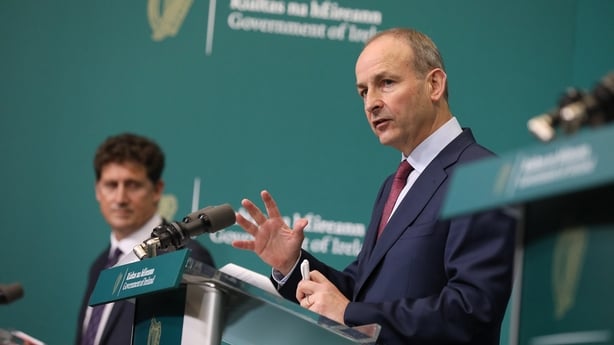Two lines tell us why there's growing concern about the virus among government and health officials, despite our world-leading vaccination rates. Both lines relate to intensive care units.
One shows the daily change in the percentage of ICU patients with Covid-19 since July. Back then, one in 20 ICU beds were occupied by people with Covid-19. Now, it’s one in every four.
The second line shows the percentage of ICU beds in the system that are considered available for use. Typically, there are about 300 ICU beds open each day. A percentage of them are considered "available", in that they can be used to respond to urgent need, among other things.
During the month of July, about 35 beds across our 29 acute hospitals were considered available daily, according to HSE data. Now, it's down to about 11 each day. Some 20 hospitals had no ICU availability this morning.
We need your consent to load this Datawrapper contentWe use Datawrapper to manage extra content that can set cookies on your device and collect data about your activity. Please review their details and accept them to load the content.Manage Preferences
Together, the lines show that the pressure on ICUs nationally from Covid-19 is growing, while the capacity to deal with any further demands is shrinking.
Combine them with some more data from elsewhere in the country's pandemic monitoring system, and the changing season, and you begin to see the rationale for the concern among policymakers, even if you disagree with the decisions taken on foot of it.
The number of people with Covid-19 in hospital has been steadily growing for weeks. But recently, the proportion of people being hospitalised, known as the case-to-hospitalisation rate, has increased. Previously, about 20 people were being hospitalised per 1,000 confirmed cases. That’s now about 30.
We need your consent to load this Datawrapper contentWe use Datawrapper to manage extra content that can set cookies on your device and collect data about your activity. Please review their details and accept them to load the content.Manage Preferences
The higher case-to-hospitalisation rate is thought to be linked to a higher average age among people who are being infected. Over the last month, the average age of a confirmed case of Covid-19 has gone from 23 to about 34. This means more older people are being infected – and they are more likely to be hospitalised.
We need your consent to load this Datawrapper contentWe use Datawrapper to manage extra content that can set cookies on your device and collect data about your activity. Please review their details and accept them to load the content.Manage Preferences
All this is happening as we head towards winter, a time when, even prior to the pandemic, the country's health system typically comes under significant pressure.
The obvious question is therefore: what can be done to relieve pressure on ICUs and hospitals?
Part of the proposed answer is why you're still constantly hearing members of NPHET and the HSE asking unvaccinated people to get vaccinated. Only about 10% of adults are unvaccinated, yet they account for about 60% of ICU patients.
It seems like an obvious way to minimise stress on the health system – yet, equally, it seems unlikely that high numbers of people who are still not vaccinated will now take up the offer.
The Government has said that use of Covid-19 immunity certificates will be extended, but little has changed to influence unvaccinated people to get an appointment for a jab.
If that alone won't solve the problem, the other obvious solution is to reduce the extent to which the virus is circulating in the community.

That’s easily talked about, but less easily achieved. Around 40% of people in hospital recently are considered to have had a "breakthrough infection" – they were fully vaccinated, yet still got sick.
Generally speaking, the more Covid that is circulating, the more breakthrough cases that will occur, since people get exposed more often to the virus over the course of the day. That'll eventually have a knock-on impact in hospitals.
Reducing case numbers would reduce hospitalisations, and – the theory goes - disproportionately reduce breakthrough infections.
The theory is fine, the execution more difficult.
The simplest way to reduce case numbers would be to impose new restrictions. That's not something anyone wants to see happen. NPHET has not suggested that, and the Government hasn't chosen to do it.
Instead, the aim is to bring down case numbers by slowing the planned reopening, introducing additional antigen testing procedures, and appealing to people's sense of personal responsibility.
The hope is that the latest surge in the numbers is temporary – that people will change their behaviour, that cases will fall, and so will hospitalisations. That may well happen.
If it doesn't, people in the health system – and potentially people elsewhere – are looking at a particularly long winter.






